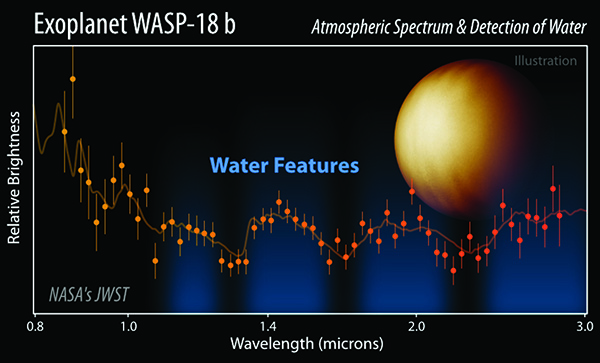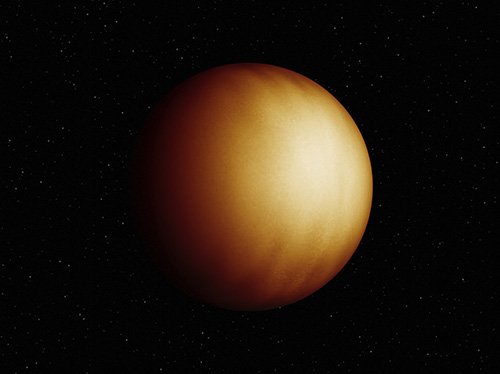There’s an intriguing exoplanet out there—400 light-years out there—that is so tantalizing astronomers have been studying it since its discovery in 2009. A year for WASP-18b (one orbit of its star) takes just 23 hours. There’s nothing like it in our solar system. In addition to observatories on the ground, NASA’s Hubble, Chandra, TESS, and Spitzer space telescopes have all been used to observe WASP-18b, an ultra-hot gas giant 10 times more massive than Jupiter.
Now astronomers have used NASA’s James Webb Space Telescope to identify water vapor in the atmosphere of WASP-18b and make a temperature map of the planet as it slipped behind, and reappeared from, its star. They reported their findings in a paper published May 31 in Nature.
“Unlike previous papers from our team, this one describes a secondary eclipse, which occurs when a planet disappears behind the host star,” said coauthor Natalie Batalha, a professor of astronomy and astrophysics at UC Santa Cruz who leads the JWST Transiting Exoplanet Early Release Science Team and helped coordinate the study.
“This type of observation allows us to study the thermal infrared radiation that the planet emits on the star-facing side,” she said. “The JWST observations have such high precision that we can also measure the minute variations occurring while the planet is slipping behind (and then emerging from) the limb of the star. This allows us to infer spatial information about the planetary atmosphere.”
The same side of WASP-18b always faces the star, just as the same side of the moon always faces Earth. The temperature, or brightness, map shows a huge change in temperature—up to 1,000 degrees—from the hottest point facing the star to the terminator, where day and night sides of the tidally-locked planet meet in permanent twilight.
“JWST is giving us the sensitivity to make much more detailed maps of hot giant planets like WASP-18b than ever before,” said coauthor Megan Mansfield, a Sagan Fellow at the University of Arizona. “This is the first time a planet has been mapped with JWST, and it’s really exciting to see that some of what our models predicted, such as a sharp drop in temperature away from the point on the planet directly facing the star, is actually seen in the data.”
The team mapped temperature gradients across the day side of the planet. Given how much cooler the planet is at the terminator, there is likely something hindering winds from efficiently redistributing heat to the night side. But what is hindering the winds is still a mystery.
“The brightness map of WASP-18b shows a lack of east-west winds that is best matched by models with atmospheric drag. One possible explanation is that this planet has a strong magnetic field, which would be an exciting discovery,” said coauthor Ryan Challener of the University of Michigan.
One interpretation of the eclipse map is that magnetic effects force the winds to blow from the planet’s equator up over the North pole and down over the South pole, instead of East-West, as scientists would otherwise expect.
Researchers recorded temperature changes at different elevations of the gas giant planet’s layers of atmosphere. They saw temperatures increase with elevation, varying by hundreds of degrees.
The spectrum clearly shows multiple small but precisely measured water features, present despite the extreme temperatures of almost 5,000 degrees Fahrenheit (2,700 C). It’s so hot that it would tear most water molecules apart, so still seeing its presence speaks to Webb’s extraordinary sensitivity to detect remaining water that survived. The amounts recorded in WASP-18b’s atmosphere indicate water vapor at various elevations.
“It was a great feeling to look at WASP-18b’s JWST spectrum for the first time and see the subtle but precisely measured signature of water,” said Louis-Philippe Coulombe, a graduate student at the University of Montreal and lead author of the WASP-18b paper. “Using such measurements, we will be able to detect such molecules for a wide range of planets in the years to come.”
Researchers looked at WASP-18 b for about six hours with one of Webb’s instruments, the Near-Infrared Imager and Slitless Spectrograph (NIRISS), contributed by the Canadian Space Agency.
Proximity, both to its star and to us, helped make WASP-18 b an intriguing target for scientists, as did its large mass. WASP-18 b is one of the most massive worlds whose atmospheres we can investigate. Scientists want to know how such planets form and come to be where they are. This, too, has some early answers from Webb.
‘‘By analyzing WASP-18b’s spectrum, we not only learn about the various molecules that can be found in its atmosphere but also about the way it formed. We find from our observations that WASP-18b’s composition is very similar to that of its star, meaning it most likely formed from the leftover gas that was present just after the star was born,’’ Coulombe said. ‘‘Those results are very valuable to get a clear picture of how strange planets like WASP-18b, which have no counterpart in our solar system, come to exist.’’
More than 100 scientists around the globe are working on early science from Webb through the Transiting Exoplanet Community Early Release Science Program. In addition to Batalha, other UCSC scientists involved in this study include Xi Zhang, associate professor of Earth and planetary sciences; Jonathan Fortney, professor of astronomy and astrophysics; and postdoctoral scholars Aarynn Carter and Kazumasa Ohno.




